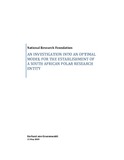
Antarctic Legacy Archive
AN INVESTIGATION INTO AN OPTIMAL MODEL FOR THE ESTABLISHMENT OF A SOUTH AFRICAN POLAR RESEARCH ENTITY
- ALSA Home
- →
- Documents
- →
- Official Documents
- →
- View Item
JavaScript is disabled for your browser. Some features of this site may not work without it.
| dc.contributor.author | von Gruenewaldt, Gerhard | |
| dc.contributor.author | National Research Foundation | |
| dc.date.accessioned | 2020-09-14T11:56:18Z | |
| dc.date.available | 2020-09-14T11:56:18Z | |
| dc.date.created | 2009-05-11 | |
| dc.identifier.uri | http://hdl.handle.net/123456789/21380 | |
| dc.description.abstract | South Africa’s research activities in the Southern Oceans and Antarctica are a direct consequence of its obligations as a signatory of the Antarctic Treaty Systems. In addition, though there are a number of Agencies of Government with a direct interest in Antarctica and the Southern Oceans, with the latter defined in the Terms of Reference as embracing the oceans to the south of the mainland. Taken together the following four categories of stakeholders of a new Polar and Southern Ocean research entity can be identified: 1. Those that have, traditionally, been part of the South African National Antarctic Programme (SANAP) and whose activities have by and large been in support of adherence to the principles of the Antarctic Treaty Systems. This work is virtually exclusively been undertaken by researchers at universities with the research topics approved on the basis of peer review and availability of logistic support. 2. Those whose work is carried out by virtue of a statutory mandate and includes the activities of Marine and Coastal Management (MCM) of the Department of Environmental Affairs and Tourism (DEAT) and the South African Weather Service (SAWS). 3. Those that have a statutory mandate of conducting investigations in South African territory of the Southern Oceans such as South African National Biodiversity Institute (SANBI), the Council for Geoscience (CGS) and the Petroleum Agency of South Africa (PASA) but have not been part of the activities of SANAP. 4. Those will participate in the Global Change Grand Challenge (GCGC) of the Department of Science and Technology’s (DST) ten year plan, an activity identified as one of the highest priority for South Africa to understand climate change and the impact this will have on South Africa. Within the context of the South African National System of Innovation (NSI) three governance models can be considered, viz.: • A National Facility as defined in the System Wide Review of 1998 and to become part of the National Research Foundation (NRF) which has the mandate of managing National Facilities in terms of the NRF Act; • A division within an existing statutory Science Council such as the CSIR; and • A separate statutory Science Council reporting to the Minister of Science and Technology. | en_ZA |
| dc.description.sponsorship | Department of Science and Technology | en_ZA |
| dc.language.iso | en_ZA | en_ZA |
| dc.subject | Governance | en_ZA |
| dc.subject | Research | en_ZA |
| dc.title | AN INVESTIGATION INTO AN OPTIMAL MODEL FOR THE ESTABLISHMENT OF A SOUTH AFRICAN POLAR RESEARCH ENTITY | en_ZA |
| dc.type | Other | en_ZA |
| dc.rights.holder | National Research Foundation | en_ZA |
| iso19115.mdconstraints.uselimitation | This item and the content of this website are subject to copyright protection. Reproduction of the content, or any part of it, other than for research, academic or non-commercial use is prohibited without prior consent from the copyright holder. | en_ZA |
Files in this item
This item appears in the following Collection(s)
-
Official Documents [265]
Official documents compiled within the South African National Antarctic Programme
